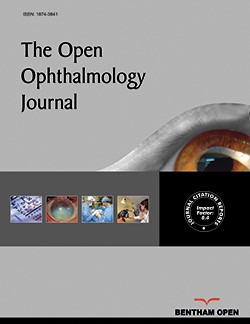All published articles of this journal are available on ScienceDirect.
Rubeosis Iridis Resulting from Agenesis of the Internal Carotid Artery: A Case Report
Abstract
We report a case of rubeosis iridis resulting from agenesis of the internal carotid artery. Agenesis of the internal carotid artery is a rare congenital anomaly, and most patients do remain asymptomatic, but we should realize that this condition may lead to ocular ischemic changes, the result being rubeosis iridis.
INTRODUCTION
Agenesis of the internal carotid artery (ICA) is a rare congenital anomaly and is usually asymptomatic because of the abundant collateral supply from other vessels [1]. Here, we report a case of rubeosis iridis resulting from agenesis of the ICA.
CASE
A 47-year-old woman presented with blurred vision in her left eye. An ophthalmic examination showed visual acuity to be 20/20 in the right eye and 20/25 in the left eye. Intraocular pressure (IOP) measured 10 mmHg in the right eye and 32 mmHg in the left eye. Slit-lamp examination revealed corneal edema and rubeosis iridis in the left eye (Fig. 1a). Gonioscopy demonstrated peripheral anterior synechia on the upper nasal side in the left eye, with unclear neovascularisation because of corneal edema. The optic disc in the left eye also had glaucomatous changes, and visual field testing showed glaucomatous defects. Moreover, the artery on the optic disc had pulsation with relatively mild IOP elevation. Retinal vessels seemed to be almost normal (Fig. 1b), but fluorescein angiography indicated the following findings: arm-retinal time was normal in both eyes; a prolonged retinal arteriovenous transit time (10 seconds in the right eye and 25 seconds in the left eye); slight retinal capillary nonperfusion in the left eye. The right eye had no abnormality of any kind. General physical and neurologic examinations were unremarkable. However, carotid Doppler ultrasound study showed the left internal carotid artery (ICA) was neither visualized nor detected. Magnetic resonance angiography showed a left dilated vertebral artery, thinned common carotid artery, and absence of ICA. Three-dimensional computed tomography angiography revealed the absence of the left ICA (Fig. 1c) and carotid canals, which confirmed agenesis of the left ICA, and supply of the left middle cerebral artery by the left posterior communicating artery. Despite use of antiglaucoma medications, IOP was higher than 30 mmHg. Trabeculectomy with use of mitomycin C was performed in November 2005.

(a) Slit-lamp examination showed corneal edema and rubeosis iridis in the left eye. (b) Fundus examination showed glaucomatous changes of the optic disc and almost normal retinal vessels. (c) Three-dimensional computed tomography angiography revealed absence of the left internal carotid artery and thinned common carotid artery (arrows). (d) A few days after the trabeculectomy, rubeosis iridis disappeared.
After trabeculectomy with no complication, IOP decreased, rubeosis iridis disappeared (Fig. 1d), and the retinal arteriovenous transit time improved to within normal limits. IOP was well controlled for 2.5 years.
DISCUSSION
Agenesis of the ICA is a rare congenital anomaly, which occurs in less than 0.01% of the population [1]. The mechanism of formation of this anomaly is not completely clear. Likely possibilities include secondary regression after a normal initial development and arrested development at a certain early embryonic stage. ICA agenesis is usually asymptomatic because of the abundant collateral supply from the contralateral ICA and basilar systems [2]. However, the new vessels are threatened by rupture with subarachnoid or meningeal hemorrhage and by ischemia [3]. Only one case, anterior ischemic optic neuropathy, has been reported as an ocular symptom of ICA agenesis [4].
That this case manifested rubeosis iridis is of interest. This patient with ICA agenesis was asymptomatic, even though blood pressure of the retinal vessel may have been mildly lower. We believe that this mildly lower blood pressure of retinal arteries, which resulted from ICA agenesis, combined with IOP elevation may have led to ischemia, the result being rubeosis iridis. Agenesis of the ICA is rare, and most patients do remain asymptomatic, but we should realize that this condition may lead to ocular ischemic changes.


